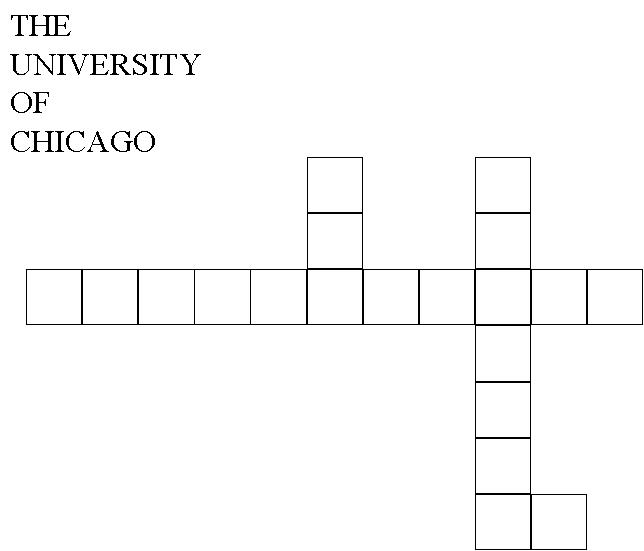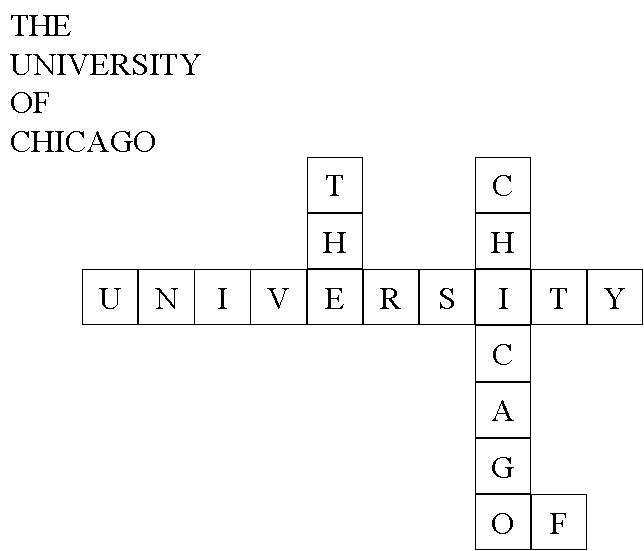![[CS logo]](../t.png)
CSPP 56553 - Artificial Intelligence
Winter 2004
Homework #2: Due January 28, 2004
Goals
Through this assignment you will:
- Formulate constaint satisfaction problems.
- Explore the effects of different constraint propagation techniques and heuristic strategies on the size of solvable CSPs.
- Formulate problems for solution by genetic algorithms.
Background
In this assignment we examine the problem of finding a consistent set of
assignments to a set of variables, X1, X2,...Xn, where each
variable Xi takes its values from a domain Di. The assignments are restricted by a set of pairwise constraints between the variables. The constraints can be arbitrary functions, so
the problems described can be quite general.
Problem 1
We begin by examining a common problem and reformulating it as
a constraint satisfaction problem.
Here we will analyze a simplification of the crossword puzzle problem.
In this variant, we assume that we have a set of words W1, W2,...Wn and a crossword puzzle grid. Our goal is to fill the crossword
grid with the words such that letters of intersecting words match.
An example of an uncompleted puzzle and a completed puzzle appear below.


Provide a constraint satisfaction problem formulation for this variant of
the crossword puzzle problem.
Part A
Specify the variables to which values are to be assigned.
Part B
Specify the domains from which the variables take their values.
Part C
Define the constraints that must hold between variables.
Please provide pseudo-code defining the constraints explicitly.
Part D
Give a simple example of a "fill-in" (crossword) puzzle of the type above that
demonstrates the limitations of arc-consistency type constraint
propagation for solving constraint satisfaction problems.
Part E
Explain why constraint satisfaction procedures based on backtracking
search are not subject to this problem.
Part F
Briefly describe the use of the iterative refinement, min-conflict
strategy to solve the crossword puzzle problem.
Part G
Demonstrate the application of your procedure on a simple 4 word
example puzzle.
Background 2
The remaining problems will compare the effectiveness of different strategies
for solving constraint satisfaction problems such as the one defined above.
We will make use of the java applet from MIT demonstrated in class that
solves the map coloring problem. This applet can be found here. It requires the
Java 2 plug-in, so all details required to answer the problems are
included below.
Problem 2
The applet demonstrated in class uses a basic backtracking procedure
as the foundation for finding solutions to the constraint satisfaction
problem.
Part A
When we run the map-coloring applet with 4 colors on the map of the
continental United States, we observe that when a solution is
finally reached no constraints checks have
been performed. Explain the mechanism that plain backtracking search
needs to use to find valid labelings without constraint checks.
Part B
Conversely, backtracking with forward checking performs 492
constraint checks, and encounters 0 dead ends. Explain briefly
how forward checking avoids dead ends.
Problem 3
In the discussion above, we assumed a static alphabetical ordering
on nodes to search. Here we try apply some heuristics to find
satisfying assignments more rapidly.
Part A
Selecting the most constrained variable to expand next in backtracking
with forward checking results
in a legal coloring after 299 constraint checks and 0 dead ends.
In contrast, the naive alphabetic ordering required 492 constraint
checks and 0 dead ends. Explain this improvement by characterizing
the impact of the selection of most constrained variable on measures
associated with cost of depth-first backtracking search.
Part B
Although it might seem counter-intuitive, the best choice of
value assignment is often "least constraining". Explain
briefly why one would choose to make the least constraining
value assignment to a variable.
Background 3
Genetic algorithms build on a biological analogy
as mechanism for local search and learning.
The inspiration lies in Darwin's theory of evolution by natural selection.
In natural evolution, individuals have traits carried by genes on chromosomes
that are passed on to offspring. Variation in genetic make-up arise
through mutation - copying errors - and crossover combining material from
different chromosomes. The fittest individuals survive to have more
offspring.
Genetic algorithms map the structure of the search problem onto
evolutionary analogs. The features or parameters of the search space
map to genes and are grouped into chromosomes. Mutations correspond
to random changes in some number of feature values. Crossover likewise
corresponds to swapping feature values for some subset of genes
between a pair of chromosomes. Finally one has to define a measure
of fitness. We explored the standard method, rank method, and rank-space
methods of computing fitness as the probability of an individual's survival
to the next generation. These measures draw on assessments of quality,
diversity or both.
Problem 4: Mastermind
Mastermind is a game in which one player creates a pattern of
colored pegs, which they hide from the other player. The other
player's goal is to guess the hidden pattern of pegs based on
limited feedback (number of correct colors, number of correctly
positioned pegs). Here we will consider using GAs to evolve a solution to
the mastermind matching game.
In this variant of the game, the pegs will take on the colors of
the rainbow: red, orange, yellow, green, blue, indigo, violet.
If we had all the processing power of a computer to solve
this problem, we could try to guess a longer than typical string,
20 pegs in length, "rgybvgbiyoroggviiybo".
Formulate mastermind as a GA. Specifically, specify the
mapping to genes and chromosomes. Describe a quality measure.
Describe a mutation operator.
![[CS logo]](../t.png)
![[CS logo]](../t.png)

